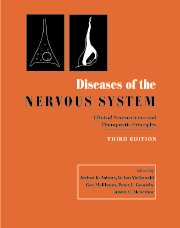Book contents
- Frontmatter
- Dedication
- Contents
- List of contributors
- Editor's preface
- PART I INTRODUCTION AND GENERAL PRINCIPLES
- PART II DISORDERS OF HIGHER FUNCTION
- 13 Congenital disorders of cerebral cortical development
- 14 The aging brain: morphology, imaging and function
- 15 Neurodegenerative diseases
- 16 Aging and dementia: principles, evaluation and diagnosis
- 17 Alzheimer's Disease
- 18 Dementia with Lewy bodies
- 19 Frontotemporal dementia
- 20 Consciousness and its disorders
- 21 Mechanisms of memory and amnestic syndromes
- 22 Acquired disorders of language
- 23 Neglect
- 24 Brain death
- 25 Disorders of mood
- 26 Schizophrenia
- 27 Obsessive–compulsive disorder
- 28 Autism and autistic spectrum disorders
- 29 Attention deficit hyperactivity disorder: spectrum and mechanisms
- 30 The neurobiology of drug addition
- PART III DISORDERS OF MOTOR CONTROL
- PART IV DISORDERS OF THE SPECIAL SENSES
- PART V DISORDERS OF SPINE AND SPINAL CORD
- PART VI DISORDERS OF BODY FUNCTION
- PART VII HEADACHE AND PAIN
- PART VIII NEUROMUSCULAR DISORDERS
- PART IX EPILEPSY
- PART X CEREBROVASCULAR DISORDERS
- PART XI NEOPLASTIC DISORDERS
- PART XII AUTOIMMUNE DISORDERS
- PART XIII DISORDERS OF MYELIN
- PART XIV INFECTIONS
- PART XV TRAUMA AND TOXIC DISORDERS
- PART XVI DEGENERATIVE DISORDERS
- PART XVII NEUROLOGICAL MANIFESTATIONS OF SYSTEMIC CONDITIONS
- Complete two-volume index
- Plate Section
17 - Alzheimer's Disease
from PART II - DISORDERS OF HIGHER FUNCTION
Published online by Cambridge University Press: 05 August 2016
- Frontmatter
- Dedication
- Contents
- List of contributors
- Editor's preface
- PART I INTRODUCTION AND GENERAL PRINCIPLES
- PART II DISORDERS OF HIGHER FUNCTION
- 13 Congenital disorders of cerebral cortical development
- 14 The aging brain: morphology, imaging and function
- 15 Neurodegenerative diseases
- 16 Aging and dementia: principles, evaluation and diagnosis
- 17 Alzheimer's Disease
- 18 Dementia with Lewy bodies
- 19 Frontotemporal dementia
- 20 Consciousness and its disorders
- 21 Mechanisms of memory and amnestic syndromes
- 22 Acquired disorders of language
- 23 Neglect
- 24 Brain death
- 25 Disorders of mood
- 26 Schizophrenia
- 27 Obsessive–compulsive disorder
- 28 Autism and autistic spectrum disorders
- 29 Attention deficit hyperactivity disorder: spectrum and mechanisms
- 30 The neurobiology of drug addition
- PART III DISORDERS OF MOTOR CONTROL
- PART IV DISORDERS OF THE SPECIAL SENSES
- PART V DISORDERS OF SPINE AND SPINAL CORD
- PART VI DISORDERS OF BODY FUNCTION
- PART VII HEADACHE AND PAIN
- PART VIII NEUROMUSCULAR DISORDERS
- PART IX EPILEPSY
- PART X CEREBROVASCULAR DISORDERS
- PART XI NEOPLASTIC DISORDERS
- PART XII AUTOIMMUNE DISORDERS
- PART XIII DISORDERS OF MYELIN
- PART XIV INFECTIONS
- PART XV TRAUMA AND TOXIC DISORDERS
- PART XVI DEGENERATIVE DISORDERS
- PART XVII NEUROLOGICAL MANIFESTATIONS OF SYSTEMIC CONDITIONS
- Complete two-volume index
- Plate Section
Summary
Alzheimer's disease (AD) is an age-related, neurodegenerative disorder that represents the most common cause of dementia and is one of the leading causes of medical morbidity and mortality in the developed world. The implications of increasing longevity and shifting population demographics have led to the recognition of AD as a public health problem of major proportions. The percentage of the US population over age 65 will more than double over the next 30 to 40 years. According to these projections, as many as 10 million persons will be afflicted with dementia, the majority of whom will suffer from AD, with associated annual health care costs of over $100 billion (Cummings, 1995). On a personal level, the insidious but relentless decline in the affected individual's cognitive and functional abilities imposes a particularly heavy burden on patient, caregivers and family members alike. These considerations have greatly increased public awareness of AD during the past 20 years, and have stimulated the increasingly rapid pace of scientific progress directed toward the development of effective, disease-modifying treatments.
Historical perspective
In 1907, Alois Alzheimer published the initial report of the clinical and pathologic features of the disease that was soon named after him by Emil Kraepelin (Alzheimer, 1907; Kraepelin, 1910; Maurer et al., 1997). This report summarized a lecture he had given the prior year on the case of ‘Auguste D’, a 51-year-old woman admitted in 1901 to the Hospital for the Mentally Ill and Epileptics in Frankfurt, Germany. Alzheimer described a syndrome of ‘rapidly increasing memory impairments’, aphasia, disorientation, paranoia, and auditory hallucinations. His detailed histopathological analysis upon her death in 1906, which was aided by the new staining techniques introduced by his colleague Franz Nissl, revealed ‘numerous small miliary foci … caused by the deposition of a peculiar substance in the cortex’. These ‘foci’ or neuritic plaques, as they came to be called, were accompanied by extensive loss of cortical neurons and striking neurofibrillary changes: ‘In the center of an otherwise normal cell there stand out one or several fibrils due to their characteristic thickness and peculiar impregnability.’ Alzheimer provided a more thorough description of this original case, along with an account of a second case (‘Johann F’.) from his Munich clinic, in a subsequent publication that included numerous illustrations of the characteristic neuritic plaques and neurofibrillary tangles (Alzheimer, 1911).
- Type
- Chapter
- Information
- Diseases of the Nervous SystemClinical Neuroscience and Therapeutic Principles, pp. 252 - 266Publisher: Cambridge University PressPrint publication year: 2002
- 1
- Cited by

